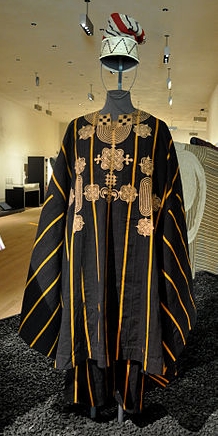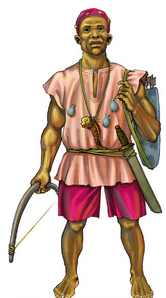
support@yorubalibrary.com
+2348073529208, 07038599574

The Sanyan is a prestigious and culturally significant traditional attire among the Yoruba people. Made from aso-oke fabric, the Sanyan is often reserved for special occasions and ceremonies, symbolizing elegance, status, and cultural pride.
The Cultural Significance of Sanyan
Sanyan holds a prominent place in Yoruba culture as a symbol of nobility and tradition. It is often worn during important events such as weddings, festivals, and chieftaincy ceremonies. Wearing Sanyan signifies respect for Yoruba heritage and adherence to cultural values.
The Aso-Oke Fabric
Aso-oke, meaning "top cloth," is the fabric used to make Sanyan. It is handwoven on traditional looms using high-quality threads. The three primary types of aso-oke are:
• Etu: Typically dark blue, resembling guinea fowl feathers.
• Alaari: Deep red, often associated with royalty.
• Sanyan: Pale brown or light gray, made from locally grown cotton or wild silk.
Sanyan is particularly valued for its durability and luxurious appearance, often featuring intricate patterns and designs.
Weaving Techniques
Creating aso-oke involves skilled artisans who employ traditional weaving techniques passed down through generations. Key steps include:
1. Spinning: Cotton or silk fibers are spun into threads.
2. Dyeing: Threads are dyed using natural dyes to achieve the desired color.
3. Weaving: The dyed threads are woven on horizontal looms to create strips of fabric, which are then sewn together to form larger pieces.
The weaving process is labor-intensive and requires great expertise to produce the high-quality Sanyan fabric.
Design and Patterns
Sanyan fabric is known for its distinctive patterns, which can include geometric shapes, stripes, and motifs inspired by nature and Yoruba culture. Common patterns found on Sanyan include:
• Gegemu: Striped designs that are bold and striking.
• Olokun: Wave-like patterns symbolizing wealth and prosperity.
• Alagogo: Checkerboard designs representing unity and strength.
Each pattern carries its own meaning and significance, adding to the cultural richness of the attire.
Wearing the Sanyan
Sanyan is traditionally worn in various styles, depending on the occasion and the wearer's preference. Common ways to wear Sanyan include:
• Agbada: A flowing, wide-sleeved robe often worn by men over a buba (top) and sokoto (trousers).
• Iro and Buba: A wrap skirt and blouse ensemble typically worn by women, often accompanied by a matching gele (head tie).
• Buba and Sokoto: A simple, elegant outfit consisting of a top and trousers, suitable for both men and women.
Accessorizing with beads, jewelry, and other traditional items enhances the elegance and cultural authenticity of the Sanyan attire.
Contemporary Adaptations
In modern times, Sanyan has been adapted to suit contemporary fashion while retaining its traditional essence. Designers incorporate Sanyan into modern styles, creating outfits that blend tradition and modernity. This evolution helps keep the tradition alive and relevant, appealing to both younger and older generations.
Conclusion
The Sanyan is a testament to the rich cultural heritage and craftsmanship of the Yoruba people. Its intricate patterns, durable fabric, and elegant designs make it a cherished attire for special occasions. Wearing Sanyan is a way to honor Yoruba traditions, celebrate cultural identity, and showcase the timeless beauty of aso-oke fabric.

Learn about the Yoruba concept of Ìwà Pẹ̀lẹ́ (good…

Learn special praises for Divine Being and Creator…